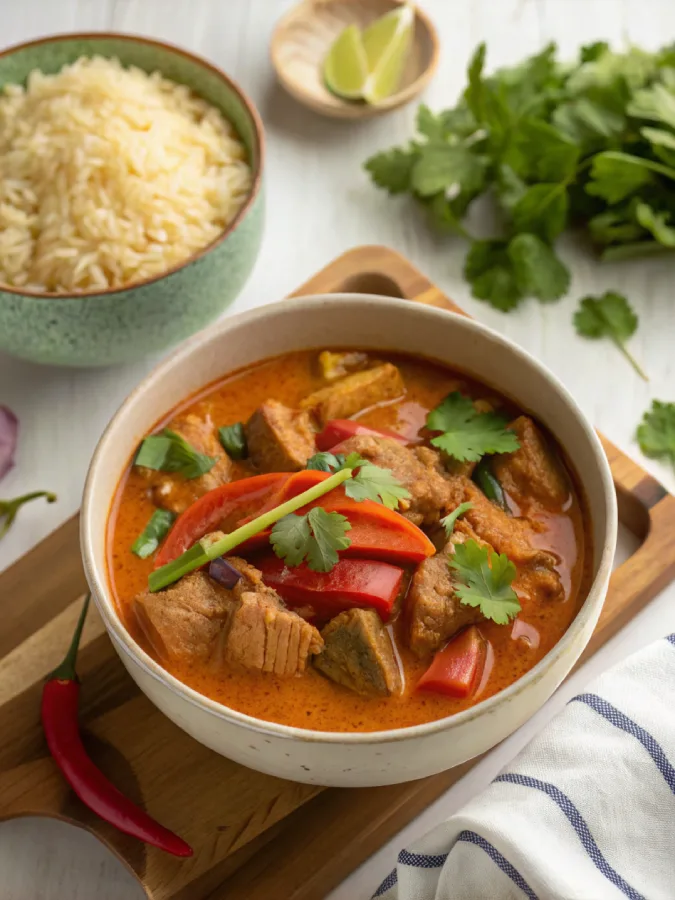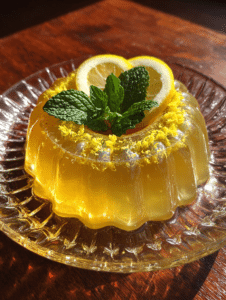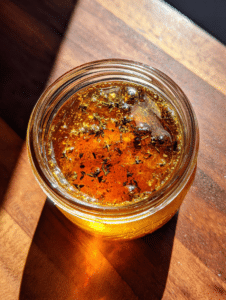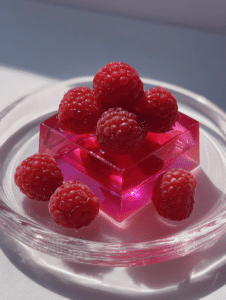Disclaimer: This content is for educational purposes only, not medical advice. Always consult with a doctor before making significant changes to your diet, especially if you have pre-existing health conditions.

Cooking Thai food at home always felt like a mystery to me, until I discovered how easy a good Red Thai Curry Recipe could be. It was a chilly evening, the kind that calls for something cozy but not heavy. I had a dusty jar of red curry paste in the back of the fridge, a can of coconut milk, and not much else. I threw it all in a pot with leftover chicken and a handful of vegetables, and what came out was pure magic, bold flavor, warmth, and balance in under 30 minutes.
That simple experience brought me back to a family trip to Houston’s Thai Town where I first tasted authentic red curry. Creamy, spicy, layered with lemongrass and heat, it was love at first bite. And just like that, this red Thai curry recipe became a staple in my kitchen. It’s fast, flexible, and deeply satisfying.
Whether you’re looking to clean out the fridge or wow your partner on a weeknight, this one-pot wonder delivers.
In this Article
Key Takeaways: What You Need to Know
- A great Red Thai Curry Recipe uses red curry paste, coconut milk, protein (like chicken or tofu), and vegetables.
- It’s spicy, creamy, and customizable, from heat level to veggie swaps.
- You can make your own curry paste or use store-bought, either way works.
- It cooks in under 30 minutes and pairs well with jasmine or cauliflower rice.
- We’ll answer questions like how to tweak it for your diet and what makes it different from other Thai curries.

Red Thai Curry Recipe
Equipment
- 1 Saucepan Medium-sized, nonstick
- 1 Wooden Spoon For sautéing curry paste
- 1 Measuring Cups For accurate ingredients
Ingredients
- 1 tbsp Red curry paste Thai brand or homemade
- 1 can 13oz Coconut milk Full-fat only
- 1 cup Mixed vegetables Bell peppers zucchini, etc.
- 1 cup Protein Tofu chicken, or shrimp
- 1 tbsp Fish sauce Optional for extra umami
- 1 tsp Brown sugar Or palm sugar
- 1 whole Lime Juiced for brightness
- 1 handful Thai basil Or regular basil if unavailable
- 1 tbsp Neutral oil For sautéing the paste
Instructions
- Heat oil in a saucepan over medium heat. Add the red curry paste and sauté for 30 seconds until fragrant.
- Pour in half the coconut milk and whisk to combine. Let it simmer gently.
- Add chopped vegetables and your protein of choice. Stir well.
- Pour in the remaining coconut milk and bring to a light simmer. Cook for 10–12 minutes until vegetables are tender and protein is cooked through.
- Add fish sauce and brown sugar. Stir to balance the flavors.
- Turn off the heat. Stir in lime juice and Thai basil just before serving.
- Serve hot with jasmine rice or noodles.
Notes
Nutrition
What Is Thai Red Curry and Why You’ll Love It
What makes red Thai curry unique?
When I say Thai red curry hits differently, I mean it. Unlike green or yellow curries, red Thai curry is defined by the deep, earthy heat of dried red chilies blended with lemongrass, galangal, kaffir lime, and shrimp paste. It’s bold, layered, and aromatic. While green curry has a zesty, herbal kick, and yellow curry leans mellow with turmeric, red curry strikes a savory-sweet heat balance that pairs perfectly with creamy coconut milk.
The red color comes from dried long red chilies, not fresh ones, giving it warmth without setting your mouth on fire, unless you want it to. I love the customizability of this dish. From chicken to chickpeas to tofu, it cradles almost any protein beautifully.
I started experimenting with this after making my own version of the pink salt diet recipe for an anti-inflammatory meal plan. This curry pairs perfectly with jasmine rice and some chia seeds in fruit smoothies on the side for a light dessert.
How Thai red curry became my family’s favorite dinner
Back in 2017, I was juggling a newborn and a freelance project deadline when I needed a fast, filling dinner. I had a can of coconut milk, leftover chicken, a few veggies, and a jar of red curry paste. I simmered everything together, crossed my fingers, and served it over microwave rice. My husband went silent—then said, “This is insane. Restaurant-level.” And just like that, red Thai curry recipe became a regular in our dinner rotation.
I’ve since dialed it in, swapped in local veggies, and even used it to impress my air-fryer dino nugget–loving niece who surprisingly devoured an eggplant version. It’s endlessly forgiving and gets even better the next day.
The joy of this dish is how easy it is to adapt. Some nights I use tofu and swap rice for a handful of air-fried cheese curds on the side, fusion, yes, but comfort too. And if you’re curious about making this lower in sodium, using Himalayan salt or homemade broth can help.
What Is a Red Thai Curry Recipe?
So what exactly is a red Thai curry recipe?
A red Thai curry recipe is a warm, comforting, and boldly spiced dish made with red curry paste, coconut milk, vegetables, and often a protein like chicken, tofu, or shrimp. The star of the dish is the red curry paste, traditionally made by pounding together dried red chilies, lemongrass, galangal, garlic, kaffir lime peel, and shrimp paste using a mortar and pestle. Modern kitchens often rely on high-quality store-bought pastes to save time, but the depth of flavor still shines through.
This dish simmers everything in creamy coconut milk, delivering that perfect balance of spicy, sweet, salty, and sour flavors. It’s usually served with fluffy jasmine rice, which soaks up the sauce like a dream.
The result? A deeply flavorful main dish that’s ready in about 25 minutes.
In Thailand, red curry is known as “gaeng phet”, which translates to “spicy soup.” It’s a core dish in Thai cuisine and often rotated into family meals because it’s adaptable to almost any vegetable or protein on hand. If you’ve ever loved the layered flavors in dishes like natural Mounjaro tea or homemade spice blends, red curry will feel like a natural next step in your kitchen journey.
How to Make Red Thai Curry Paste From Scratch (or Choose the Right Store-Bought Option)
What’s in traditional red Thai curry paste?
Red Thai curry paste is the beating heart of this dish. If you’ve ever tried making it at home, you know it’s a labor of love, but the payoff is unbelievably worth it. Traditional versions blend dried red chilies, lemongrass, galangal, garlic, shallots, coriander seed, and shrimp paste, pounded slowly in a mortar and pestle to develop that rich, aromatic base. For a vegetarian twist, I swap shrimp paste for fermented soybeans or miso paste.
Here’s a quick homemade version I started with when developing my natural Mounjaro recipe with pink salt:
| Ingredient | Amount |
|---|---|
| Dried red chilies (soaked) | 5–7 |
| Lemongrass stalk (chopped) | 1 |
| Shallots | 2 |
| Garlic cloves | 4 |
| Galangal or ginger | 1 tbsp |
| Shrimp paste (or miso) | 1 tsp |
Tip: Use a blender if short on time, but add a splash of oil for smoother blending.
Is store-bought curry paste worth it?
Yes, and thank goodness for it. On busy nights, I grab Mae Ploy or Thai Kitchen red curry paste (just watch the sodium and shrimp content). Some brands are fiery; others are tame. I always do a small spoon taste test first. Store-bought paste lets you build a meal fast, especially when paired with leftover rotisserie chicken or roasted veggies.
One trick I love? Toasting the paste in oil for 1–2 minutes before adding coconut milk. It blooms the spices and deepens the flavor, much like what I learned when testing my apple cider vinegar and cranberry juice detox broth.
If you’re watching your macros or building a lighter version, pair your curry with air-fried sides like these waffle fries or even serve with a scoop of cauliflower rice from your pink salt diet plan stash.
Choosing the Best Ingredients for Red Thai Curry Recipe (Proteins, Vegetables, and Aromatics)
What proteins work best in red Thai curry?

The joy of a good red Thai curry recipe is its flexibility. Traditional Thai red curry with chicken is the most popular version, using juicy, simmered chicken thighs that soak up the rich coconut sauce. But I’ve swapped in tofu, shrimp, and even chickpeas with equally craveable results.
When I’m in a hurry, I shred leftovers from my last batch of bariatric seed recipe and toss them in, packed with protein and surprisingly perfect in curry. On plant-based days, I use tofu or edamame, and when I need extra comfort food vibes, leftover chicken from el Monterey burrito in the air fryer night goes straight into the pot.
Red Thai curry recipe is such a forgiving recipe. It’s the kind of dish where even air-fried nuggets from the freezer, yes, those from my niece’s favorite air-fryer dino nuggets, can turn into a quirky, delicious meal. That’s how adaptable it is.
Tip: Always brown or air-fry proteins lightly before adding to the curry to help them hold texture in the simmering sauce.
Best vegetables for Thai curry? Think color and crunch.
Thai red curry needs color, texture, and layers. I always go for a mix of vegetables that stand up to a hot broth and don’t turn to mush. Here are my must-haves:
- Bell peppers and carrots for sweetness and brightness
- Zucchini or Japanese eggplant to soak up the flavor
- Green beans for snap
- Bamboo shoots or baby corn for that classic Thai texture
I’ve also folded in air-fried sides like air-fried cheese curds or sautéed vegetables from my pink salt trick recipe leftovers, especially if I’m craving a fusion twist.
And on lighter days, I pair curry with a bright drink like my apple cider vinegar and cranberry juice for a refreshing finish.
If you want to stretch the dish, try scooping curry over shredded hash browns in the air fryer, they crisp beautifully and create a savory base that rivals rice.
Do You Put Lime Juice in Thai Red Curry?
Yes, you absolutely should! Lime juice is a key component that brings out the full flavor of this red Thai curry recipe. The acidity cuts through the richness of coconut milk and balances the heat of the chili paste. For best results, always add it after cooking, just before serving.
If you’re someone who already loves citrus-forward drinks like the apple cider vinegar detox, this curry will feel right in line with your flavor preferences.

How to Customize Thai Red Curry (Spice Levels, Coconut Milk, Gluten-Free & More)
How spicy is Thai red curry, and can you tone it down?
Let’s be real, Thai red curry can be spicy, but it doesn’t have to torch your mouth. The heat level depends on your curry paste and how many chilies were used in its base. Store-bought brands like Thai Kitchen are usually mild-to-medium, while brands like Mae Ploy are definitely hotter.
The great news? You control the spice. I’ve had weeks where I needed something mellow and soothing, so I thinned the curry with more coconut milk and added a spoon of honey to round it out. Other times, I was craving intensity and tossed in extra chilies or a drizzle of pink salt diet broth concentrate to punch things up.
If you’re cooking for spice-sensitive eaters (like my mom, who thinks black pepper is “a lot”), start small and offer chili oil or Himalayan salt trick chili paste on the side.
Tip: Add spice at the end in layers—once it’s in, it’s hard to take out.
Dairy-free, gluten-free, low-carb? Easy.
Thai cuisine is naturally flexible, and red Thai curry recipe is a rockstar when it comes to dietary swaps. Coconut milk is dairy-free by nature, making this a creamy dish without any cream. Just be sure to read the label, some brands sneak in additives.
Here are my favorite swaps:
- Gluten-free: Most curry pastes are safe, but double-check for soy sauce or hidden wheat. Serve over cauliflower rice or even crispy air fryer waffle fries for a fun side.
- Low-carb or keto: Skip the rice and try this curry with sautéed greens or roasted cauliflower. I’ve even served it with air-fried tofu cubes from my natural Mounjaro tea recipe meal prep kit, fantastic.
- No coconut milk? Swap in cashew cream or almond milk with a splash of oil for richness.
I’ve also tossed in detox-friendly sides like the pink salt trick for weight loss to complement the anti-inflammatory ingredients. If you’re managing macros, this dish gives you total control.
Real-life review: “This curry saved my dinner party”
“I was hosting six people and forgot to defrost anything. Abby’s red Thai curry saved me. I used the store-bought paste, leftover sweet potato, chickpeas, and a can of coconut milk. Everyone thought it was catered!”
–Jess L., reader from Dallas, TX
This isn’t just a recipe, it’s a weeknight hero, a date-night star, and the ultimate fridge clean-out solution.
What Gives Thai Red Curry Its Flavor?
What’s the real reason red Thai curry tastes so layered and bold?
The unmistakable depth in a red Thai curry recipe comes primarily from the curry paste. It’s a concentrated blend of dried red chilies, lemongrass, galangal, shallots, garlic, kaffir lime peel, and shrimp paste (or soy-based versions for vegan options). This paste is the flavor engine of the dish, rich, spicy, and aromatic.
Once the paste hits warm oil in your pan, it blooms. That’s when its essential oils release their magic and perfume your kitchen with warm, savory spice. Add full-fat coconut milk and you create a silky, spiced broth that coats every bite with flavor.
Mastering the Balance: Sweet, Salty, Spicy, Sour
A great Thai red curry recipe hits all four traditional Thai flavor pillars:
- Salty from fish sauce or soy sauce
- Spicy from the red chili paste
- Sweet from palm sugar or brown sugar
- Sour from lime juice or tamarind
You can adjust each to your preference. Too spicy? Add more coconut milk or a touch of sugar. Too bland? A splash of lime or fish sauce will wake it up.
This balancing act is what makes red curry more than just a meal, it’s a flavor experience. It’s the same kind of flavor depth readers love in smart sips like the cranberry apple cider vinegar detox.
What if you want it less spicy?
Choose curry paste brands labeled “mild” or reduce the amount to ½ tablespoon. Add a little grated ginger for warmth without the heat. Taming spice doesn’t mean sacrificing flavor.
Flavor Pro Tip: Always taste your curry before serving and adjust with small amounts of lime juice, fish sauce, or sugar. This last-minute seasoning is the real chef’s trick to turning a good curry into a great one.
Cooking Red Thai Curry Step-by-Step (Timing, Simmering, Finishing Touches)
How do you cook red Thai curry like a pro?
When it comes to building a standout red Thai curry recipe, timing is everything. You don’t want soggy vegetables or overcooked protein. I’ve found a simple 3-step rhythm that delivers bold flavor and balanced texture every time:
Step 1: Bloom the curry paste.
Start by heating oil in a pan and adding your homemade or store-bought curry paste. Stir it for 1–2 minutes until the kitchen smells amazing. This wakes up all the aromatics, think lemongrass, garlic, and chilies. I learned this step the hard way while improvising my first version with leftover chicken from my natural Mounjaro recipe, skipping the bloom made it taste flat.
Step 2: Add coconut milk and protein.
Pour in full-fat coconut milk and stir until smooth. Let it simmer gently, then drop in your protein of choice, whether it’s tofu, shrimp, or chicken from your pink salt diet recipe leftovers. Simmer 10–15 minutes until the protein is cooked through.
Step 3: Finish with vegetables and herbs.
Add your chopped vegetables (bell peppers, zucchini, carrots). These don’t need long, just 5–7 minutes. I throw in fresh Thai basil or cilantro at the end, and sometimes a squirt of lime juice to balance the richness.
Serve it hot over jasmine rice, or go rogue with frozen hash brown patties in the air fryer as a crispy base. Sounds crazy? It works.
Finishing touches that make it feel restaurant-level
The difference between good curry and great curry is the little things. Here’s how I take it over the top:
- Drizzle of chili oil or a swirl of coconut cream for contrast
- A handful of Thai basil added just before serving
- A squeeze of lime juice to brighten the dish
- A spoon of fish sauce or tamari for depth
Pair it with a cooling side like chia seeds in yogurt or even a scoop of Japanese pink salt weight loss cucumber salad for contrast.
Every time I make this, I remember why it became a family favorite. It’s foolproof, deeply comforting, and ready in under 30 minutes.
Serving and Storing Your Red Thai Curry Recipe Like a Pro
What’s the best way to serve a red Thai curry recipe?
A red Thai curry recipe shines brightest when it’s poured generously over steaming jasmine rice. The creamy, spiced sauce seeps into every grain, making each bite pop with bold flavor. But rice isn’t your only option.
You can serve this red Thai curry recipe with:
- Cauliflower rice for a low-carb twist
- Rice noodles for a slurp-worthy bowl
- Crispy air fryer hash browns to soak up every drop
- Or rice cakes for texture contrast
If you love balance, pair your curry with a tangy sip of apple cider vinegar and cranberry juice for weight loss or a cup of pink salt recipe soup to round out the meal with minerals and depth.
Tip: Curry thickened too much in the pot? Stir in a splash of coconut milk or stock to revive its silky texture.
This red Thai curry recipe isn’t just versatile, it’s a crowd-pleaser every single time. And when you’ve got a flavorful dish like this, your sides can be simple.
Can you meal prep or freeze a red Thai curry recipe?
Yes, and it gets even better the next day. The beauty of a red Thai curry recipe is that its flavors deepen overnight. That’s why it’s one of my top picks for batch cooking.
Here’s how to store and reheat your curry like a pro:
Fridge (up to 4 days):
- Cool your red Thai curry fully before storing.
- Use airtight containers.
- Reheat over medium heat, stirring often.
- Add water or coconut milk if it thickens too much.
Freezer (up to 2 months):
- Let your curry cool completely.
- Transfer to freezer-safe containers or bags.
- Label, freeze flat, and thaw in the fridge overnight before reheating.
Want a meal-prep hack? Make a double batch of the red Thai curry recipe base (just the paste and coconut milk). Freeze it without vegetables. Then toss in fresh produce when reheating, so everything stays crisp and vibrant.
I’ve even poured reheated curry over hash brown patties in the air fryer for a bold, Thai-inspired brunch. Wild? Maybe. Delicious? Absolutely.
When prepping for the week, I pair my frozen curry with hydrating snacks like Japanese pink salt and ice recipe smoothies for a vibrant finish to any meal.
Frequently Asked Questions About the Red Thai Curry Recipe
What is Thai red curry?
Thai red curry is a bold, coconut-based curry made with red chili paste, herbs, and aromatics. The signature red color comes from dried red chilies, blended with garlic, lemongrass, galangal, shallots, and shrimp paste. A classic red Thai curry recipe features a rich, spicy-sweet profile, balanced with creamy coconut milk. It’s often served with rice and a variety of proteins and vegetables. You’ll find it similar to other Thai curries but spicier and deeper in flavor compared to its yellow or green cousins.
Need a beginner-friendly version? Try my full red Thai curry recipe that takes under 30 minutes.
How to make the red Thai curry recipe?
To make an authentic red Thai curry recipe, start by sautéing red curry paste in oil until aromatic. Add full-fat coconut milk, protein (like chicken or tofu), and vegetables. Simmer gently, then finish with fresh lime juice and Thai basil. The key is to balance spicy, salty, sweet, and sour flavors. For a visual step-by-step, refer to our instructions in Part 3 above.
What does a Thai red curry taste like?
A Thai red curry is rich, spicy, slightly sweet, and deeply savory. The coconut milk gives it creaminess, while lime juice and fish sauce add brightness and umami. The taste is layered, with heat from red chilies and freshness from Thai basil. It’s bold but incredibly balanced.
What ingredients are in Thai red curry?
An authentic red Thai curry recipe includes red curry paste, coconut milk, vegetables, protein, fish sauce or soy sauce, lime juice, sugar (usually palm or brown), and Thai herbs like basil. You can learn more about safe and balanced meal ingredients from MyPlate.gov.
What is the secret to good Thai curry?
The secret to a standout red Thai curry recipe lies in the order of cooking and quality of ingredients. Sauté the curry paste in oil, use full-fat coconut milk, and finish with lime juice and herbs. Always taste and adjust at the end, balance is key to perfect Thai flavor.
What is Thai red curry with chicken?
Thai red curry with chicken is the most popular version of this dish. It combines tender chicken, usually thigh meat, with red curry paste and coconut milk. The result is a flavorful, comforting dish that works perfectly with steamed rice. In our red Thai curry version, we balance spice with sweetness using carrots, bell peppers, and basil. If you’re following a low-carb plan, swap the rice with frozen hash brown patties in air fryer for a creative base.
How do you make Thai red curry paste?
To make authentic Thai red curry paste, you’ll blend soaked dried red chilies, lemongrass, garlic, shallots, galangal (or ginger), coriander seeds, and shrimp paste. For a vegetarian version, use miso instead of shrimp paste. You can also make a quick batch with pantry items. We included a full paste recipe in Part 2 of the red Thai curry recipe.
What are the best vegetables for Thai curry?
The best vegetables for a red Thai curry recipe are ones that stay firm but soak up flavor. I always reach for:
Bell peppers
Carrots
Eggplant or zucchini
Bamboo shoots or green beans
Conclusion: Why This Red Thai Curry Recipe Deserves a Spot in Your Weekly Rotation
This red Thai curry recipe delivers comfort, spice, and simplicity in one satisfying pot. With just a few pantry ingredients and fresh vegetables, you can create a balanced main dish that feels like a restaurant-level meal, without the cost or complexity. The magic is in the balance: creamy coconut milk, bold red curry paste, and a final squeeze of lime juice that brightens everything.
Whether you’re feeding your family or prepping for solo dinners, this recipe adapts to your kitchen and lifestyle. Add it to your weekly menu and pair it with nourishing sides like the pink salt detox drink or light meals from our wellness recipe collection.
It’s quick. It’s customizable. And it’s the kind of dish that’ll keep your spoon going back for more.




I will give it a try for sure, I love Asian Cuisine